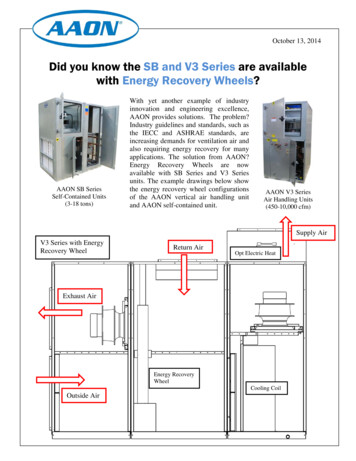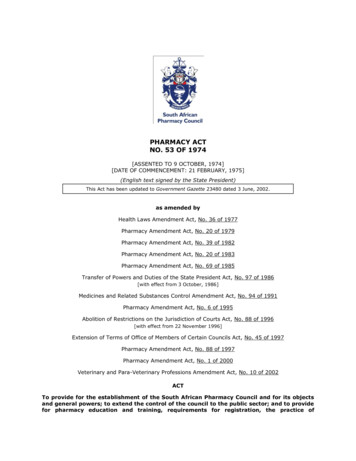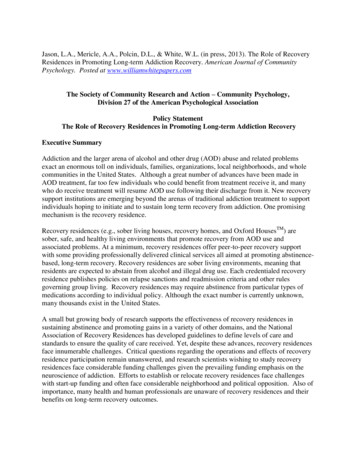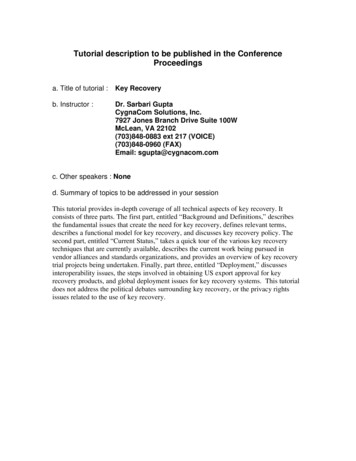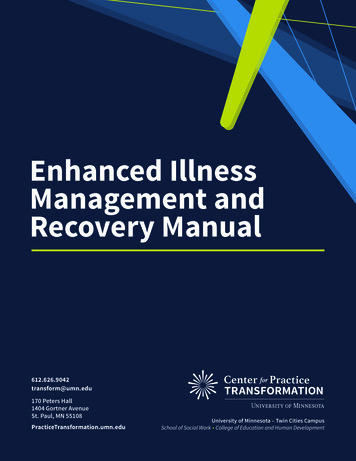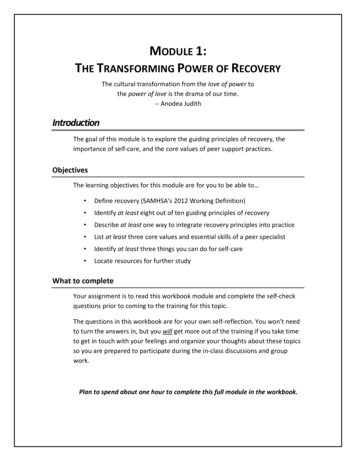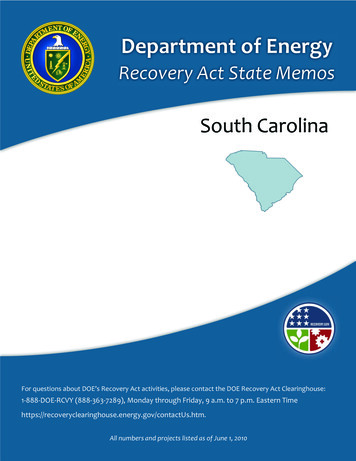
Transcription
Department of EnergyRecovery Act State MemosSouth CarolinaFor questions about DOE’s Recovery Act activities, please contact the DOE Recovery Act Clearinghouse:1-888-DOE-RCVY (888-363-7289), Monday through Friday, 9 a.m. to 7 p.m. Eastern ctUs.htm.All numbers and projects listed as of June 1, 2010
TABLE OF CONTENTSRECOVERY ACT SNAPSHOT. 1FUNDING ALLOCATION TABLE. 2ENERGY EFFICIENCY . 3RENEWABLE ENERGY . 4ELECTRIC GRID . 6TRANSPORTATION . 7CARBON CAPTURE AND STORAGE . 7ENVIRONMENTAL CLEANUP . 8SCIENCE AND INNOVATION . 9RECOVERY ACT SUCCESS STORIES – ENERGY EMPOWERS South Carolina company expands transformer production for U.S. market . 10Technicians receive training for South Carolina's muggy weather 10Rebates bring cool air, business to South Carolina . 11Brightening South Carolina’s state capitol . 11
U.S. DEPARTMENT OF ENERGY SOUTH CAROLINA RECOVERY ACT SNAPSHOTFunding for selected DOE projects: 1.6 billionDOE Recovery Act projects in South Carolina: 63Clean energy tax credits and grants: 5For total Recovery Act jobs numbers in SouthCarolina go to www.recovery.govSouth Carolina has substantial nuclear and hydroelectric resources.The American Recovery & Reinvestment Act (ARRA) is making ameaningful down payment on the nation’s energy andenvironmental future. The Recovery Act investments in SouthCarolina reflect a broad range of clean energy projects, from energyefficiency and the smart grid to wind and solar, as well as nearly 1.6billion to accelerate the environmental cleanup efforts at theSavannah River Site. Through these investments, South Carolina’sbusinesses, Clemson University, non‐profits, and local governmentsare creating quality jobs today and positioning South Carolina toplay an important role in the new energy economy of the future.EXAMPLES OF SOUTH CAROLINA FORMULA GRANTSProgramAward(in millions)State EnergyProgramWeatherization AssistanceProgramEnergy EfficiencyEnergy Efficiency ApplianceConservation Block Grants Rebate Program 50.6 58.9 31.6 4.3The South CarolinaOffice of the StateTreasurer has received 50.6 million to investin state‐level energyefficiency andrenewable energypriorities.The South Carolina Governor’sOffice has received 58.9million to scale‐up existingweatherization efforts in thestate, creating jobs, reducingcarbon emissions and savingmoney for South Carolina’slow‐income families. Over thecourse of the Recovery Act,South Carolina expects toweatherize approximately6,500 homes.Twenty‐two communitiesin South Carolina receiveda total of 31.6 million todevelop, promote,implement, and managelocal energy efficiencyprograms.The Office of the StateTreasurer has received 4.3 million to offerconsumer rebates forpurchasing certainENERGY STAR appliances, which reduceenergy use and savemoney for families, whilehelping the environmentand supporting the localeconomy.EXAMPLES OF SOUTH CAROLINA COMPETITIVE GRANTS AND TAX CREDITSAward 1.4 billion 43.2 million 26.9 million 15.1 millionThe Savannah RiverSite received nearly 1.4 billion to createjobs and acceleratethe site’s legacywaste cleanupefforts.Clemson University wasawarded 44.6 million fora wind energy test facilityin North Charleston.General Electric GasTurbines, LLC, based inGreenville, was awarded aclean energymanufacturing tax creditfor 26.9 million tomanufacture heavy‐dutygas turbines that willdeliver greater output andefficiency.KEMET Corporation inSimpsonville wasawarded 15.1 million toproduce DC buscapacitors necessary forelectric drive systempower electronics.www.energy.gov/recovery
U.S. Department of EnergyFunding Allocation Table (Figure 1)Total dollar amounts in this document are accurate as of June 1, 2010. Please note that Recovery Act Programs are ongoing and thedollar amounts are subject to change. Recipient locations are based on project sites rather than recipients’ headquarters locations.Recovery ActPillarEnergyEfficiencyFlagship Program Names & Funding Type1Weatherization Assistance Program (F)1 58.9State Energy Program (F)1 50.6Energy Efficiency and Conservation Block Grant (F)22 31.6Energy Efficient Appliance Rebate (F)1 4.3Industrial Efficiency (CM)1 0.3Additional Programs (CM & C)TOTAL Energy EfficiencyRenewableEnergyElectric GridTransportationCarbon Captureand StorageEnvironmental CleanupScience and Innovation 2.5 148.22 1.0Wind (CM)2 44.6TOTAL Renewable Energy4 45.6State and Local Energy Assurance and Regulatory Assistance (F)2 1.5Smart Grid Workforce Training (CM)1 0.7TOTAL Electric Grid3 2.2Advanced Battery Manufacturing (CM)2 50.1Advanced Fuels (CM)1 0.6TOTAL Transportation3 50.7Geologic Characterization Projects (CM)1 5.0TOTAL Carbon Capture and Storage1 5.0Environmental Management Contracts (C)23 1,362.5TOTAL Environmental Cleanup23 1,362.5Energy Frontier Research Centers (CM)1 1.1Small Business Research (SBIR/STTR ) (CM)1 0.1TOTAL Science and Innovation2 1.263 1,615.4Payments for Renewable Energy Generation in Lieu of Tax Credits(1603)1 0.1Clean Energy Manufacturing Tax Credits (48C)4 38.7TOTAL Tax Incentives5 38.868 1,654.2TOTAL - DOE/Treasury DOE1F Formula127Solar(CM)TOTAL - DOE Programs3Tax Credits/Payments4Number of Selected AmountSelections(in millions)2Grant, CM Competitive Grant, C Contract2"Selected"indicates DOE has selected a potential funding recipient, which begins the process of negotiating an agreement. This does notnecessarily indicate that a final agreement has been reached.3Totaldoes not include administrative funds.4Jointlyadministered by DOE and the U.S. Department of Treasury.www.energy.gov/recovery
ENERGY EFFICIENCY – 27 projects totaling 148.2 millionHelping millions of American families cut utility bills by making homes and appliances moreenergy efficient, expanding the home efficiency industry in sales and manufacturing. For moreinformation, visit m.Award(s): 58.9 million, Weatherization Assistance Program (WAP)Location: StatewideThe South Carolina Governor’s Office received 58.9 million to scale‐up existing weatherizationefforts in the state, creating jobs, reducing carbon emissions and saving money for South Carolina’slow‐income families. Over the course of the Recovery Act, South Carolina expects to weatherizeapproximately 6,500 homes. The Weatherization Assistance Program (WAP) enables low‐incomefamilies to permanently reduce their energy bills by making their homes more energy efficient. Fundsimprove the energy performance of houses using the most advanced technologies and testingprotocols available in the housing industry.Award(s): 50.6 million, State Energy Program (SEP)Location: StatewideThe South Carolina Office of the State Treasurer received 50.6 million to invest in state‐level energyefficiency and renewable energy priorities. The State Energy Program (SEP) funding for SouthCarolina is providing grants and loans to improve energy efficiency in public school districts, publiccolleges and universities, and state agencies. This funding will reduce the burden of energy bills fortaxpayers, while creating jobs and reducing greenhouse gas emissions. South Carolina also intends toprovide financial assistance to various industrial, commercial and small business entities in support ofenergy efficiency and renewable energy projects. This financial assistance, along with education andtraining programs included in the SEP, is creating clean energy jobs in the state, while makingbusiness and industry more economically stable.Award(s): 22 totaling 31.6 million, Energy Efficiency and Conservation Block Grant Program(EECBG)Location: StatewideRecipients: Aiken County, Anderson County, Beaufort County, Catawba Indian Nation (aka CatawbaTribe of South Carolina), Charleston, Columbia, Florence County, Goose Creek, Greenville, GreenvilleCounty, Horry County, Lexington County, Town of Mount Pleasant, North Charleston, RichlandCounty, Rock Hill, South Carolina State Energy Office, Spartanburg, Spartanburg County, Town ofSummerville, Sumter, York CountyTwenty‐two communities in South Carolina received a total of 31.6 million to develop, promote,implement and manage local energy efficiency programs.This project assists states, U.S. territories, Indian tribes, counties and cities to develop, promote,implement and manage localized energy efficiency programs through individual program grants. Theproject funds programs which reduce fossil fuel emissions in a manner that is environmentallysustainable, maximizes cost savings, reduces the total energy use of eligible entities and improvesenergy efficiency in the transportation, building and other appropriate sectors. Examples of EECBGsinclude:3
Lexington County ‐ 2.3 millionLexington County is using this funding for building improvements that will reduce energy bills.The Lexington historic courthouse received 940,000 in improvements, including new water andair systems, new windows and new lighting. Similar improvements are being made at eight otheroffice buildings, with new lighting at nineteen of the county's 24 fire stations. The county alsoaccounted for 20,500 to continue a successful lawn mower exchange program with RichlandCounty. That annual program, first held in April 2007, allows citizens to replace gas‐poweredmowers with electric ones. Columbia ‐ 1.4 millionWith this grant, Columbia is investing in lighting upgrades for six buildings, including parkbuildings, office buildings, City Hall, and police and fire stations.Award(s): 4.3 million, Energy Efficient Appliance Rebate ProgramsLocation: StatewideThe Office of the State Treasurer received 4.3 million to offer consumer rebates for purchasingcertain ENERGY STAR appliances, which reduce energy use and save money for families, whilesupporting the local economy. This funding assists state‐level rebate programs by paying up to 50percent of the administrative costs of establishing and executing these types of programs. Thoughstates and territories determine the appliances which apply, these typically include clothes washers,dishwashers, refrigerators, freezers, room air conditioners and water heaters.Award(s): 300,000, Advanced Materials RD&D in Support of EERE Needs to Advance Clean EnergyTechnologies and Energy‐Intensive Process R&DLocation: AikenSavannah River Nuclear Solutions, LLC, in Aiken received 300,000 for Advanced Materials RD&D inSupport of EERE Needs to Advance Clean Energy Technologies and Energy‐Intensive Process R&D.This funding supports research and development on anti‐reflection coatings for high efficientcrystalline silicon solar cells.Award(s): 2.5 million, Ground Source Heat PumpsLocation: GreenvilleFurman University in Greenville received 2.5 million for Ground Source Heat Pumps. Pumps arebeing installed in eleven student housing buildings on campus, covering 1,020 students in 255apartments. Furman also plans to use this grant as a teaching tool, catalyst and model for itsstudents and other universities. The Shi Center for Sustainability will conduct data gathering andanalysis of the project's effectiveness in reducing greenhouse gases, thus transforming almost 40percent of campus student housing into a living laboratory on the effectiveness of this renewableenergy technology.4
RENEWABLE ENERGY – 9 projects totaling 84.4 millionDeveloping the clean renewable resources in order to double our supply of renewable energyand boost domestic renewable manufacturing capacity. For more information, y.htm.Award(s): 149,000 from DOE / Treasury, 1603 Payment for Renewable Energy GenerationLocation: Columbia* For current number of 1603 awards, see the weekly update at y Corporation in Columbia received 149,000 for a fuel cell project.Award(s): 4 totaling 38.7 million from DOE / Treasury, Clean Energy Manufacturing Tax Credits(48C)Location: Statewide General Electric Gas Turbines, LLC, Greenville ‐ 26.9 millionGeneral Electric Gas Turbines, LLC, in Greenville received 26.9 million to manufacture heavy‐dutygas turbines that will deliver greater output and efficiency. Itron, West Union ‐ 5.2 millionItron in West Union received 5.2 million to re‐equip an existing facility to produce the OpenWayCENTRON meter, a fully inter‐operable, solid‐state smart meter with a built‐in, two‐waycommunications path and integrated remote on / off switch. The CENTRON meter is the firstadvanced meter for the residential market. It provides open‐standards architecture, modulardesign for communications, flexibility and extensive functionality to support Smart Gridinfrastructure. Metglas, Inc., Conway ‐ 4.9 millionMetglas, Inc., in Conway received 4.9 million to purchase equipment for a casting expansionthat will increase domestic production of amorphous metals. These metals comprise the core ofthe most energy efficient transformers. The equipment will reduce the amount of electricity lostin transformer distribution. Kaydon, Sumter ‐ 1.8 millionKaydon in Sumter received 1.8 million to re‐equip and expand an existing manufacturing facilityto produce critical pitch and yaw bearings used in the production and assembly of wind energyturbines.Award(s): 16,000, Concentrating Solar PowerLocation: AikenSavannah River Nuclear Solutions, LLC, in Aiken received 16,000 to characterize and investiagateionic liquid nanofluids for corrosion and erosion behavior when in contact with common stainlesssteels at high temperatures.5
Award(s): 1 million, PV Systems DevelopmentLocation: AikenSavannah River Nuclear Solutions, LLC, in Aiken, received 1 million for PV Systems Development.Development includes a project that enhances the heat transfer and solar thermal energy collectionof CSP systems by dispersing small volume percentages of nanoparticles into the ionic liquid carriers.If successful, this could result in a 10‐40 percent improvement in thermal conductivity.Award(s): 2 totaling 44.6 million, Wind Turbine Drivetrain Testing FacilityLocation: North Charleston, Aiken Clemson University, North Charleston ‐ 43.2 millionClemson University in North Charleston received 43.2 million for a wind energy test facility inNorth Charleston. The Large Wind Turbine Drivetrain Testing facility enables the U.S., which leadsthe world in wind energy capacity, to expand development and testing of large‐scale windturbine drive‐train systems. Wind turbine sizes have increased with each generation of turbinesand have outgrown the capacity of existing U.S. drivetrain testing facilities. The new testingcapability will ultimately improve U.S. competitiveness in wind energy technology, lower energycosts for consumers and maintain rapid growth in the deployment of wind energy systems. Thenew facility is to be located at the Charleston Naval Complex, a former Navy base in NorthCharleston and will be a part of the Clemson University Restoration Institute campus. Savannah River Nuclear Solutions, LLC, Aiken ‐ 1.4 millionSavannah River Nuclear Solutions, LLC, in Aiken received 1.4 million to provide direct technicalassistance in the design, specification, integration, configuration and deployment of a highfidelity, custom Data Acquisition System (DAS) for the Large Wind Turbine Drive Train TestingFacility.MODERNIZING THE ELECTRIC GRID – 3 projects totaling 2.2 millionHarnessing clean energy sources and integrating them onto a modernized electric grid, whilegiving consumers better choices and more control over their energy use. For more information,visit (s): 611,000, Enhancing State and Local Governments’ Energy AssuranceLocation: ColombiaThe South Carolina Office of the State Treasurer in Columbia received 611,000 to focus on buildingregional energy assurance capabilities by enhancing inter‐ and intra‐state coordination andcooperation during energy emergencies. This project funds states to update and develop StateEnergy Assurance Plans that incorporate new energy portfolios such as wind, renewables, andbiofuels. This program also funds cities updating and developing Energy Assurance Plans within localareas. The two sets of funding are being used to hire or retrain staff, building in‐house expertise inthe areas of Smart Grids, critical energy infrastructure interdependencies and cyber‐security.Award(s): 744,000, Smart Grid Workforce TrainingLocation: ClemsonClemson University’s Electric Power Research Association in Clemson received 744,000 for SmartGrid Workforce Training. This project involves a Power Industry Essentials Certificate Program whichis designed to train the power engineering sector on the fundamentals of power systems and the6
advanced applications on power systems operation, control and protection. The project isdeveloping three certificate programs, Power Systems Engineering, Renewable Energy andAdvanced Power Systems, as well as a Masters of Engineering Program.Award(s): 864,000, State Assistance on Electricity PoliciesLocation: ColumbiaState of South Carolina Comptroller General in Columbia received 864,000 for State Assistance onElectricity Policies. This project funds states and their Public Utility Commissions (PUCs) to hire stafftrained to facilitate the review of time‐sensitive requests approving electric utility expendituresundertaken as part of the Recovery Act.TRANSPORTATION – 3 projects totaling 50.7 millionInvesting in a new generation of advanced fuels and vehicles to reduce our dependence onforeign oil and revitalize domestic manufacturing. For more information, ward(s): 2 totaling 50.1 million, Advanced Battery ManufacturingLocation: Schaumburg, SimpsonvilleThese projects will accelerate the development of U.S. manufacturing capacity for batteries andelectric drive components as well as the deployment of electric drive vehicles, helping to establishAmerican leadership in creating the next generation of advanced vehicles. The initiative marks thesingle largest investment in advanced battery technology for hybrid and electric‐drive vehicles evermade. Toda America, Inc., Schaumburg ‐ 35 millionToda America, Inc., in Schaumburg received 35 million for Advanced Battery Manufacturing. Thisproject involves production of nickel‐cobalt‐metal cathode material for lithium‐ion batteries. KEMET Corporation, Simpsonville ‐ 15.1 millionKEMET Corporation in Simpsonville received 15.1 million to produce DC bus capacitors includingsoft wound film and stacked film capacitors, both necessary for electric drive system powerelectronics.Award(s): 640,000, Fundamental Research in Key Program AreasLocation: AikenThe Agricultural Research Service received 640,000 for Fundamental Research in Key Programareas. This project is supplementing existing funding for research in biofuels, including establishmentand / or enhancement of research centers and working groups. This funding is allocated to the ForestService for the sustainability of short rotation woody biomass.7
CARBON CAPTURE AND STORAGE – 1 project totaling 5 millionDeveloping clean coal technologies so we can to utilize America’s coal resources sustainably. Formore information, visit http://www.energy.gov/recovery/ccs.htm.Award(s): 5 million, Geologic Sequestration Site CharacterizationLocation: ColumbiaThe South Carolina Research Foundation (SCRF) in Columbia received 5 million for a Carbon Captureand Storage project, titled Geologic Characterization of the South Georgia Rift Basin for SourceProximal Carbon Dioxide Storage. SCRF is evaluating the feasibility of carbon dioxide storage in theJurassic / Triassic saline formations of the buried South Georgia Rift. Scientific, technical andeconomic benefits are expected to come from this project. The South Georgia Rift saline formationswere identified as a prospective area for carbon dioxide storage with several storage characteristicunknowns that are being targeted by this project.ENVIRONMENTAL CLEANUP – 23 projects totaling 1.4 billionCreating jobs and reducing the legacy cold war footprint of the Department of Energy, andclean up the polluted land and water resources in communities. For more information, e Savannah River Site received nearly 1.4 billion to create jobs and accelerate the site’s legacywaste cleanup efforts.Award(s): 4 totaling 21 million, Savannah River Site Deactivation and Demolition, M & D AreasLocation: AikenThis deactivation and demolition (D&D) project at the Savannah River Site (SRS) includes thecomplete closure of D Area, former site of Heavy Water Production Facilities, the deactivation anddecommissioning of D‐Area Powerhouse and 30 support facilities, the complete remediation ofeleven waste units, the complete closure of M Area, former reactor fuel manufacturing area, and theremediation of nineteen waste units. Savannah River Nuclear Solutions, LLC, Aiken ‐ 21 millionConcord Personnel Services, Inc., Aiken (2) ‐ 106,000J G Masters, Inc. ‐ 18,000Award(s): 4 totaling 379.3 million, Savannah River Site Deactivation and Demolition, P & R AreasLocation: AikenBy the end of fiscal year 2011, this project will reduce the Savannah River Site (SRS) operationalfootprint by 25 percent (approximately 78 square miles) through deactivation and demolition (D&D)of Areas P and R. This ARRA funding will accelerate work scheduled in the SRS existing baseline. Savannah River Nuclear Solutions, LLC, Aiken ‐ 379 millionMAS Consultants, Inc., Aiken ‐ 148,000Concord Personnel Services, Inc., Aiken ‐ 106,0008
Award(s): 6 totaling 288.2 million, Savannah River Site Deactivation and Demolition, Soil &Groundwater Activities Site‐WideLocation: AikenThis project at the Savannah River Site (SRS) is slated to remove 3,000,000 gallons of contaminatedwater from the C Reactor disassembly basin building, remove more than 90 percent of theplutonium‐238 source term from 235‐F, complete characterization of four A‐Area waste units(approximately 18 acres), complete remediation of waste units and decommission facilities,approximately 1,220,720 square feet. Savannah River Nuclear Solutions, LLC, Aiken ‐ 226.6 millionAdvanced Technologies and Laboratories International, Aiken ‐ 183,000MAS Consultants Inc, Aiken ‐ 191,000Consolidated Safety Services, Inc., Aiken ‐ 90,000Concord Personnel Services, Inc., Aiken ‐ 106,000Award(s): 8 totaling 536.3 million, Savannah River Site Transuranic & Solid WasteLocation: AikenBy the end of fiscal year 2011, this project at the Savannah River Site (SRS) will reduce the solid wastefootprint by 75 percent, including characterization and / or off‐site disposal of the legacy transuranic(TRU) waste, and reconfiguration, relocation and replacement of impacted systems that are requiredto support remaining site operations. This ARRA Project accelerates work, particularly the removal ofthe depleted uranium oxide drums from the F Area storage facilities. Savannah River Nuclear Solutions, LLC, Aiken ‐ 532 millionCavanagh Services Group, Inc., Aiken ‐ 3.3 millionPAI Corporation, Aiken ‐ 314,000MAS Consultants, Inc., Aiken (2) ‐ 436,000McNeal Professional Services, Inc., Aiken ‐ 126,000Concord Personnel Services, Inc., Aiken (2) ‐ 106,000Award(s): 198.7 million, Liquid Waste Tank InfrastructureLocation: AikenSavannah River Remediation, LLC, in Aiken received 198.7 million for a Liquid Waste TankInfrastructure project to support base operations, waste tank closure and radioactive sludge and saltdisposition. This work includes activities that accelerate the refurbishment of existing liquid wasteinfrastructure and provides new infrastructure to increase reliability for transfer and treatment ofradioactive liquid waste. The ARRA projects will upgrade and extend the life of operating facilities,improve systems for processing waste at Saltstone and the Defense Waste Processing Facility(DWPF), providing support for the future operations of SWPF and supporting tank closure activitiesand bulk waste removal.9
SCIENCE AND INNOVATION – 2 projects totaling 1.2 millionRenewing our commitment to science and innovation to ensure global competitiveness in thefuture. For more information, visit d(s): 1.1 million, Energy Frontier Research CentersLocation: AikenSavannah River Nuclear Solutions, LLC, in Aiken received 1.1 million to build a scientific basis forbridging the gap between making nano‐structured materials and understanding how they function ina variety of energy applications.Award(s): 149,000, Small Business Innovation Research (SBIR) / Small Business TechnologyTransfer (STTR) Round 1Location: CharlestonTechfish, LLC, in Charleston received 149,000 from the Small Business Innovation Reasearch (SBIR) /(Small Business Technology Transfer) STTR program to develop a new process to increaseproduction rates of papermaking operations, helping power companies to achieve renewable energygoals, both for low‐capital and operating expense. These new facilities which are located throughoutthe country will increase jobs nationwide. This technology also applies to enzymatic biomass‐to‐ethanol plants under development.10
U.S. Department of EnergyENERGYEMPOWERS.GOVRecovery ActSuccess StoriesEnergy Empowers is a U.S. Department of Energy clean energy informationservice. Our team produces stories featuring the people and businesses thatare fueling the energy transformation and economic recovery in America.For more stories from your state, go to energyempowers.gov/SouthCarolinaConwaySouth Carolina company expands transformerproduction forU.S. marketSince the 1980s, Metglas,Inc. has manufactured anamorphous metal alloy withunique mechanical andmagnetic properties. Thealloy is primarily used toconstruct the cores of highlyefficient electrical transformerscalled Amorphous MetalTransformers (AMTs), whichare used on power grids tomanage the distribution ofelectricity from power plantsto residential, commercial andindustrial buildings.“Electricity is transmittedacross power lines at veryhigh voltage, and transformersare needed to reduce thatvoltage to a usable level,” Giant spools at Metglas' facility inConway, S.C., hold the thin metal alloysays Dave Millure, Metglas’ used in the cores of Amorphous MetalSenior VP of Sales and Transformers. Photo courtesy ofMarketing. “Amorphous Metal MetglasTransformers can be more energy efficient than traditional silicon steeltransformers, which means that power plants don’t have to generateas much electricity to begin with.”As part of the American Recovery and Reinvestment Act of 2009,Metglas received 4,890,000 in Advance manufacturing (48C) taxcredits. The money helped the company add an additional castingline at its manufacturing facility in Conway, S.C., that has increasedthe facility’s production capacity by 50 percent and provided 25additional factory jobs.The expansion began in August 2009; Metglas has added 10additional employees to man the new line. According to Dave Millure,Metglas’ Senior VP of Sales and Marketing, the company plans toadd 15 more full time employees within the next year. Those jobsare a boon to South Carolina, which, according to the U.S. Bureau ofLabor and Statistics, had the nation’s seventh highest unemploymentrate in May 2010. Horry County, where Metglas’ facility is located,had an unemployment rate of 10.7 percent in May 2010, accordingto the South Carolina Department of Employment and Workforce.Targeting domestic marketWith the new casting line in place, Metglas’ South Carolina facilitycan produce enough alloy to build 150,000 AMTs a year.Traditionally, Metglas has exported most of its alloy overseas, butMillure says the new casting line was built to service the domesticwww.energyempowers.gov/SouthCarolina“The community [in Charleston] doesn’t realize what you can dowith energy efficiency. There is no negative. Who doesn’t wantto cut their energy bill?” – Tim Fulford, environment projectsmanager at Trident Technical Collegemarket, as American power companies continue to look for ways toincrease energy efficiency and reduce operating costs.Electrical transformers use the principle of magnetic induction toreduce voltage to a useable level, and the process requires transformersto constantly maintain an alternating magnetic field within theircores. The random molecular structure and thin nature of Metglas’amorphous metal alloy allows AMTs to maintain a magnetic fieldwithout losing as much energy through friction and other means astraditional silicon steel transformers. This reduces the total amountof energy needed to maintain the alternating magnetic field in AMTsby 60-70 percent, making them much more energy efficient thantraditional transformers.To manufacture the alloy, Metglas uses a proprietary process inwhich the alloy’s components are melted together. The liquid is thansubjected to a rapid cooling process, which prevents the atoms fromcrystallizing naturally and leaves them in an amorphous state. Theprocess produces little material waste. “Any metal that ends
Furman University in Greenville received 2.5 million for Ground Source Heat Pumps. Pumps are being installed in eleven student housing buildings on campus, covering 1,020 students in 255 apartments. Furman also plans to use




